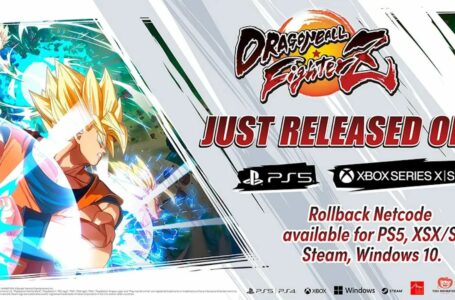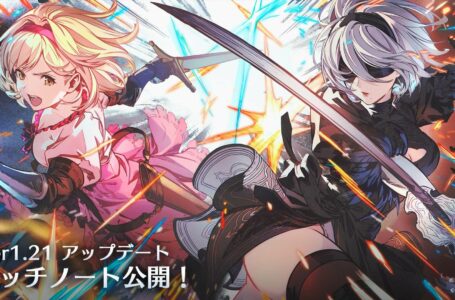The History of Kunio-kun: Nekketsu Renegade Kunio-kun
The Kunio-kun series is a long and proud one, but up until quite recently the western audience has only had the opportunity to experience a few distinct entries in it — and in heavily localised form. With the release of WayForward’s excellent River City Girls in 2019, however, beat ’em up fans found themselves with a renewed interest in the series as a whole as well as arcade-style games in general — and current Kunio-kun rights holders Arc System Works were more than happy to oblige us with the Double Dragon and Kunio-kun Retro Brawler Bundle.
Retrospectives on the Kunio-kun series typically focus on its most well-known installments — and their western incarnations, to boot. So with this series, we’re going to be taking a look at all the Japanese Kunio-kun games in their newly translated incarnations from the Double Dragon and Kunio-kun Retro Brawler Bundle, and explore their grander context in the history of the beloved beat ’em up genre.
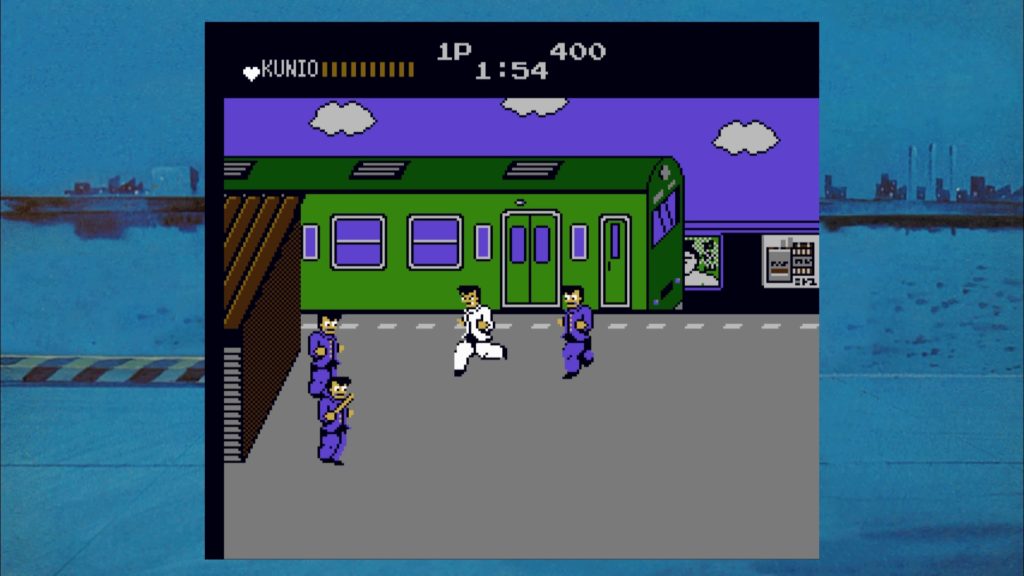
The first we’ll be taking a look at is one that will likely already be familiar to many western players, albeit in its previous westernised form, simply known as Renegade. Nekketsu Renegade Kunio-kun, also known as Nekketsu Kōha Kunio-kun (literally “hot-blooded tough guy Kunio”, or simply “renegade Kunio”) is a defining entry in the beat ’em up genre, and it helped to establish a number of factors we take for granted today.
Before we get into that, let’s take a quick look at the differences between the Japanese original and the westernised version. The differences are relatively minor, and they primarily relate to the perceived audience for the game. Back in 1986, the western world was less familiar with Japanese popular media such as anime and manga, and thus perhaps wouldn’t have had exposure to the distinctive subculture of Japanese teenage delinquents. And, back then, new things were scary — particularly if you hoped to make money from them.
Consequently, in an attempt to be more “relatable”, Renegade was repositioned as an American gangland brawl modelled after 1979 flick The Warriors, with the justification for our now-nameless hero’s fistpunching adventures now being that he was simply in the wrong part of town at the wrong time and found himself beset with swarms of people who wanted to beat the snot out of him.
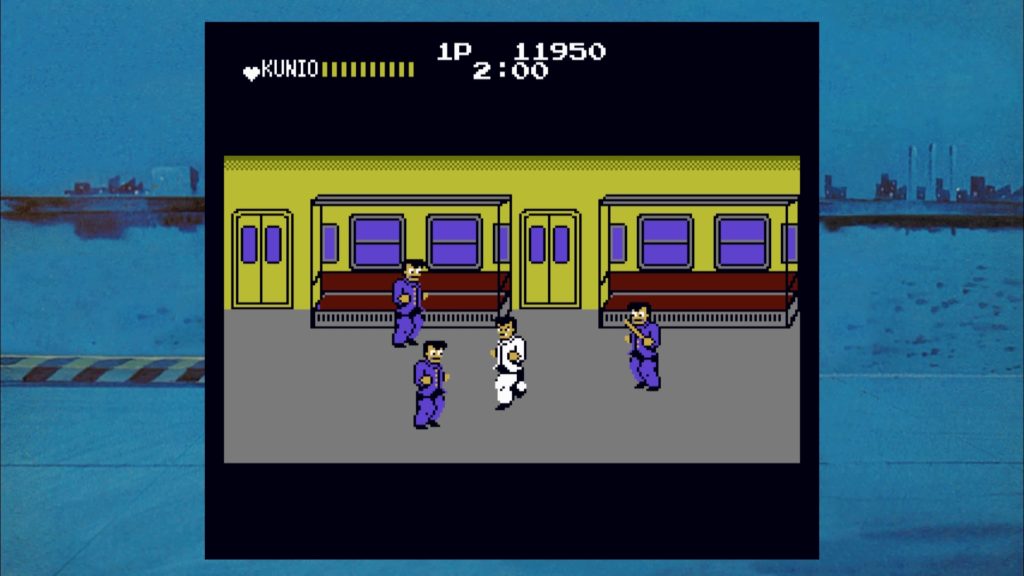
Nekketsu Renegade Kunio-kun, meanwhile, tells the story of our young hero Kunio, a new transfer student who struck up a relationship with the downtrodden Hiroshi. As the game opens, Hiroshi is kidnapped, and Kunio, hating this sort of injustice, swears to bring him back.
At least, that’s the story for the Famicom version, which is the version found in the Double Dragon and Kunio-kun Retro Brawler Bundle, and the version we’re primarily concerning ourselves with today. In the original 1986 arcade release of Renegade, Kunio is taking revenge for Hiroshi being badly beaten; it’s a minor difference to the setup, but it does change the context slightly.
As you might expect from a game that first released in 1986, story isn’t a particularly strong aspect of Nekketsu Renegade Kunio-kun — though it is worth noting that many of the characters who appear in the game end up being recurring characters throughout the rest of the Kunio-kun series. Of particular note is first boss Riki, who ends up becoming Kunio’s best friend and rival throughout most of the other games, and third boss sukeban (girl gang leader) Misuzu, who puts in a particularly memorable return appearance in River City Girls.
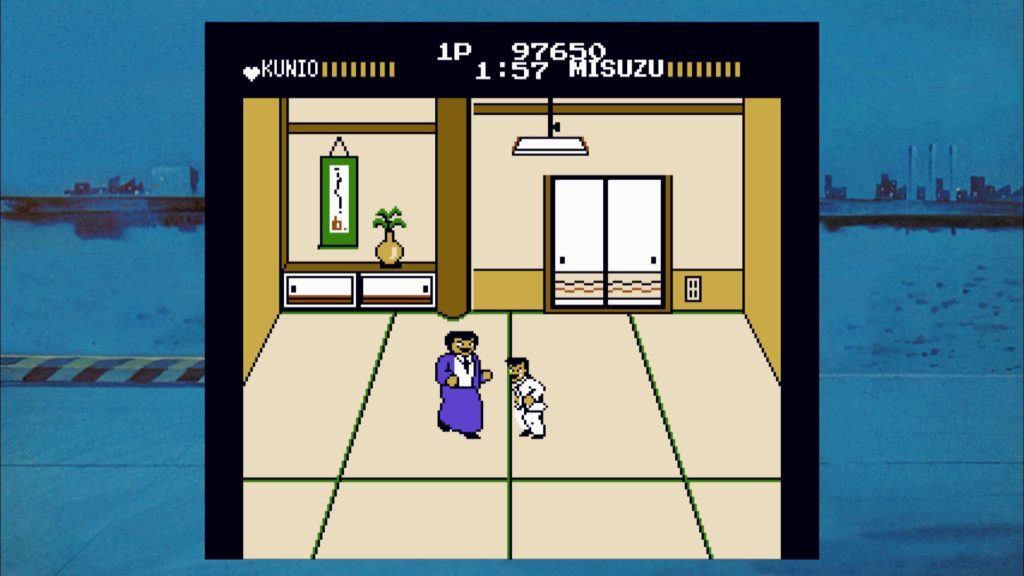
So let’s take a look at how Nekketsu Renegade Kunio-kun plays, because, as previously noted, this is a game that helped to define the beat ’em up genre as we know it today.
Prior to Nekketsu Renegade Kunio-kun, we’d seen a few games with a “fighting” theme in the arcades and for home systems. Perhaps the most notable of these were Irem’s Kung Fu Master and Data East’s Karate Champ, both of which originally released to arcades in 1984, and both of which provided a distinctly different take on video game fighting.
Kung Fu Master offered a scrolling playfield in which protagonist Thomas had to fend off swarms of incoming enemies with punches and kicks, though all foes except bosses could be dispatched with a single attack. Karate Champ, meanwhile, provided a more structured one-on-one experience, where two karate fighters simply had to land a single clean hit on each other in order to score points and eventually win their matches.
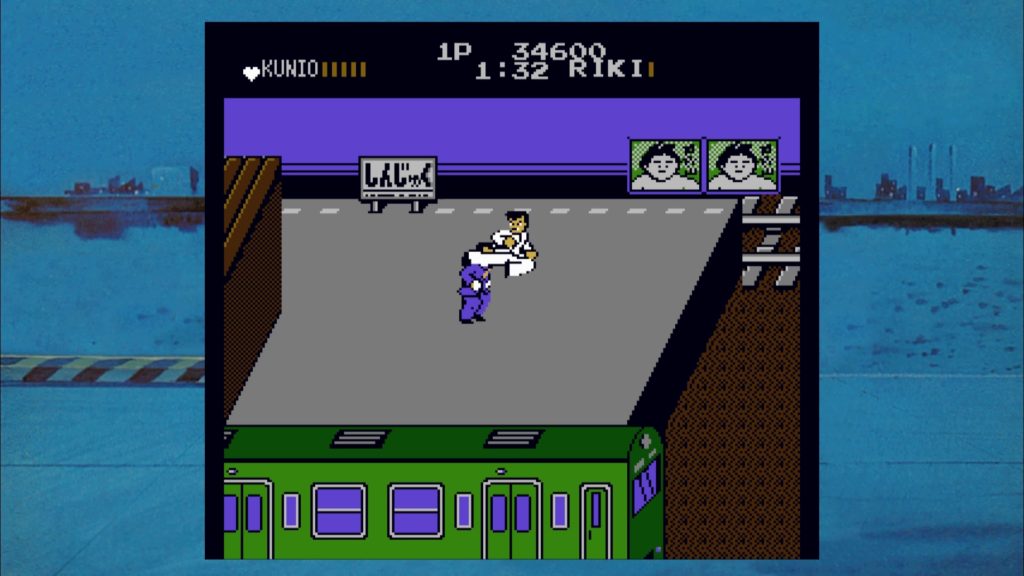
Already, with these two games, we were seeing the distinction between the beat ’em up (one against many) and fighting game (one-on-one) genres — but both titles had something of an influence on Nekketsu Renegade Kunio-kun. We had the single protagonist fighting against hordes of enemies from Kung Fu Master, and we had the variety of different moves and combat in a constrained arena offered by Karate Champ.
It was no straight clone of either, mind; it had plenty of its own innovations to add to the mix. Most notable of these was the convention that even non-boss enemies would require more than one hit to knock down. And alongside, this, there was the need for a feeling of “impact” to help the player understand when they were dealing damage. This was not an issue in Karate Champ, where rounds were decided with a single blow, and while it would have probably benefited Kung-Fu Master’s boss fights, most of the enemies in that were likewise dispatched with a single punch or kick.
Nekketsu Renegade Kunio-kun was different, though. Punch or kick an enemy and they would quite feasibly punch or kick you right back if you didn’t lay them out properly. It, of course, wouldn’t be a ton of fun if they could just lamp you in the face immediately after taking a mighty wallop to the thorax, and thus the concept of “hitstun” was born: this is a core mechanic around which the entire beat ’em up genre would come to be built.
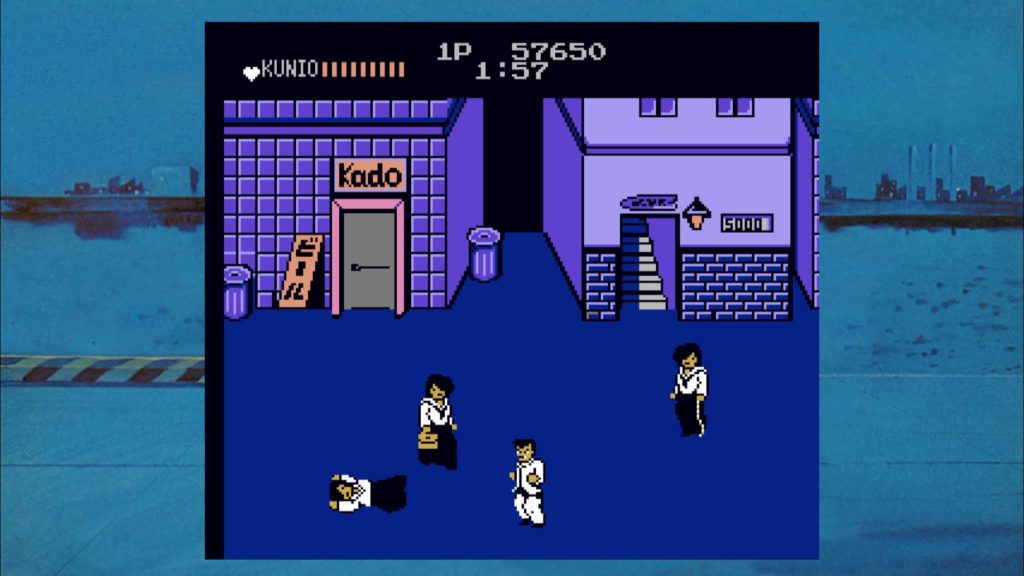
It’s simple at heart: hit someone, and they’re stunned for a moment, providing a clear visual (and often auditory) signal that your hit has connected, and an opportunity to follow up with an additional attack, ideally chaining them together into a combo. Without this concept, the beat ’em up genre would feel very different — and it would lack much of the satisfying sense of impact that causes the best beat ’em ups to still be so fondly regarded to this day.
It’s important to make good use of hitstun in Nekketsu Renegade Kunio-kun, because although your basic attacks don’t deal a lot of damage, you can make use of a simple punch to stun your enemy long enough to get them out of a troublesome situation — or to land a more powerful attack that they might otherwise be able to dodge. Punch an opponent in the face and they’ll find it much harder to avoid the flying kick you follow it up with!
This ties in with another core component of the beat ’em up genre: the idea of controlling space. Allow yourself to get surrounded in a beat ’em up and you’re going to have a bad time, and the same is very much true in Nekketsu Renegade Kunio-kun; the difference here is that rather than continually progressing onwards in a “belt-scrolling” style, you instead fight in a set arena until you’ve dealt with a set number of enemies, at which point you can move on to a subsequent part of the stage.
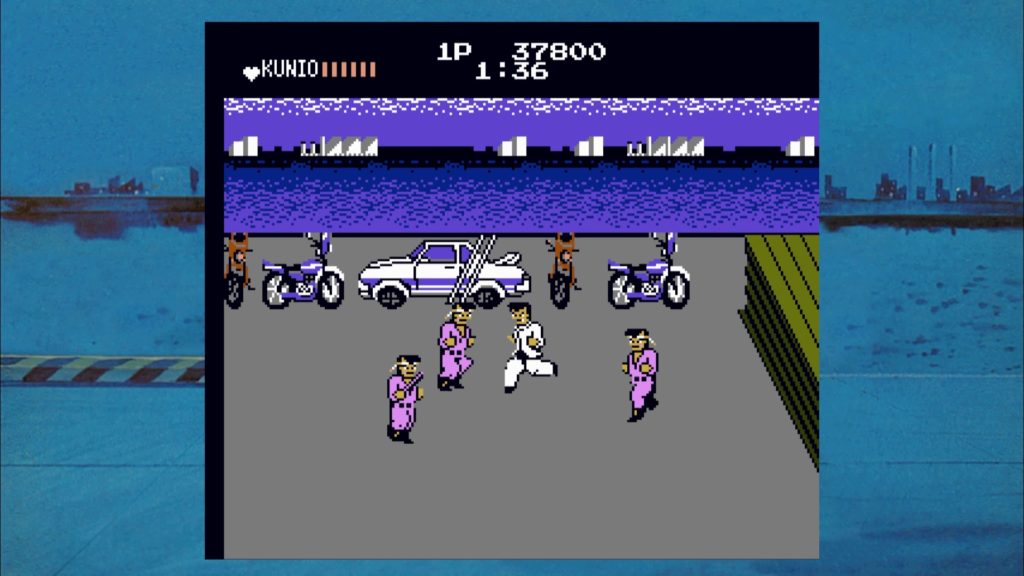
In order to help you control space in Nekketsu Renegade Kunio-kun, there are some interesting twists on the control scheme which may have been unfamiliar to players at the time of the game’s first release. Firstly, we have a rudimentary lock-on system that ensures Kunio is always facing his nearest enemy, regardless of which direction you’re moving; and secondly, we have not one, but two attack buttons: one for each direction, left or right.
Making use of these two attack buttons in various ways allows access to a variety of different moves. Press the button in the same direction that you’re facing and you’ll do a jab in front of you; press the opposite and you’ll do a sharp kick behind you. Press both and you’ll leap straight up in the air for a kick to the chin. Couple that with the ability to run by double-tapping a horizontal direction — a convention that wouldn’t become firmly established in the beat ’em up genre as a whole until many years later — and you open up a variety of other moves, such as running clotheslines, shoulder tackles and flying kicks.
The variety of different moves on offer can feel initially daunting, but you’ll find you soon get into a rhythm; early in the game, the basic enemies are best dealt with through rushing attacks, while bosses can be reliably dispatched with repeated jumping kicks before they have a chance to respond. As you progress, though, you’ll have to mix things up a little more; an interlude in the second stage tasks you with kicking grunts off their motorbikes, while the aforementioned Misuzu has such a formidable reach you’ll likely need to rethink your “kick her in the chin repeatedly” strategy.
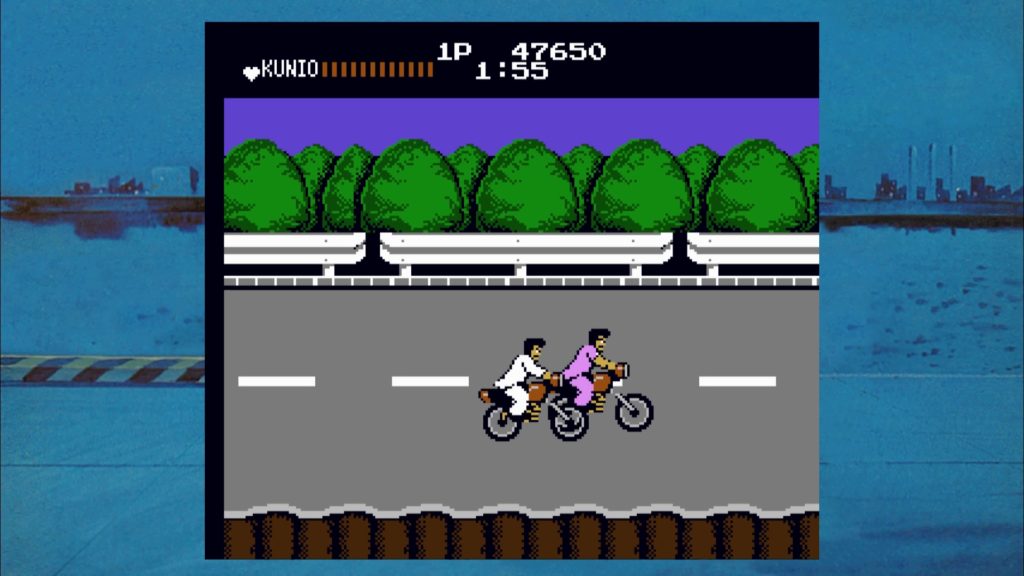
Nekketsu Renegade Kunio-kun is tough, and compared to many modern beat ’em ups it will likely feel more than a little clunky. But take the time to get to know it and there are some satisfying fighting mechanics here — plus it’s always fun to see the genesis of what would go on to become a well-established genre, as well as the beginning of a series beloved the world over.
And this, of course, is just the beginning for Kunio-kun — but there’s much more to our man than simply thumping people on the streets, as we’ll see next time!
The Double Dragon and Kunio-kun Retro Brawler Bundle is available for Nintendo Switch and PlayStation 4.
Join The Discussion
Rice Digital Discord
Rice Digital Twitter
Rice Digital Facebook
Or write us a letter for the Rice Digital Friday Letters Page by clicking here!
Disclosure: Some links in this article may be affiliate links, which means we may earn a small commission if you make a purchase after clicking on them. This is at no additional cost to you and helps support Rice Digital!
- Letter from the Editor: passing the torch - June 30, 2023
- Super Woden GP 2 is looking promising - June 30, 2023
- Inti Creates is making a 32 bit-style Love Live action platformer - June 26, 2023






